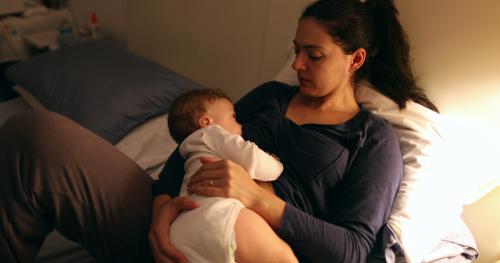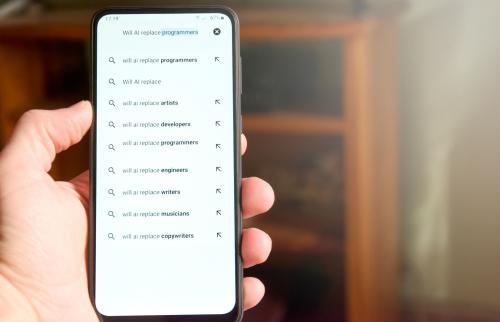Among young adults (ages 16-24), recovery from the COVID-19 recession has looked quite different from previous recessions and from the experiences of older Americans.
For those between the ages of 16 and 24, labor force participation has been falling for some time, accounting for 56 percent of the decrease in the aggregate labor force participation rate (LFPR) between 2000 and 2018, according to a Hamilton Project Report from 2020. In the past, recessions have tended to temporarily accelerate those trends; typically, during recessions and in their aftermath, there are declines in labor force participation among young people and increases in school enrollment. The reason is intuitive and predicted by economic theory: weakness in labor demand lowers the opportunity cost of not working while the future gains from greater education remain unchanged.
However, during the COVID-19 recession, young people have behaved differently than this age cohort did during the prior two recessions and differently from older cohorts. Since February 2020, young adults have spent less time on education, spent more time in the work force, and experienced better wage outcomes than over the same period following the onset of the 2001 and 2008 recessions. At the same time, more in keeping with previous postrecession periods, we find that disengagement, defined as time spent neither in education nor the labor force, has risen.
The nature of the COVID-19 pandemic was unique—in-person school was disrupted, those without caregiving responsibilities had an advantage in the labor market, and many employers raised wages to draw in workers. As young people are weighing the decision whether to enroll in school or work (or do both), they are no doubt considering the costs and benefits of schooling during the pandemic and the potential to earn labor income. In this analysis, we show how these choices have played out through the 2020-21 academic school year and the summer of 2021.
School was not a safe harbor from the economic storm
In March 2020, with the onset of the COVID-19 pandemic, schools closed their doors and moved to virtual learning to create a safe and continuous learning experience. Even though virtual learning may have the benefits of mitigating the spread of the COVID-19 virus, it also came with costs. Students questioned the quality and equity of their education as virtual learning requires students to have the proper technology (internet, computer or tablet), reduces student-teacher interaction, and lowers the amount of social interaction between students. This is especially true for postsecondary learning, where many students who attended college were confined to dorm rooms or were forced off of university campuses altogether.
In the recovery from the recent recession, the share of young adults who were enrolled in postsecondary education, meaning in a two- or four-year degree program, has declined by 1.0 percentage point during the academic year since the onset of the recession in 2020, in stark contrast to the 2001 and 2008 recessions (figure 1a). For example, enrollment in postsecondary education following the 2008 recession increased by 1.9 percentage points by the 2009-2010 academic year.

The decline in college-going can be explained in part by COVID-19’s disruption of the high school to postsecondary education pipeline. In the previous two recessions, the high school to postsecondary pipeline was strengthened. As students found the costs of attending college greater than the benefits during the COVID-19 pandemic, more young adults with a high school degree did not enroll in postsecondary education (figure 2a) compared to prior recessions: the share of young adults who graduated from high school and weren’t enrolled in college increased by more than 1.5 percentage points since the beginning of the pandemic. Time will tell whether this disruption in the continuation of education from high school to college in the United States could be explained by more high school graduates taking a gap year before attending college or whether this is a break in trends.
While we do see the share of both sexes decreasing in college enrollment and increasing in unenrolled high school graduates, males in this age group makes up a larger share of the total change (1b and 2b). According to reports from the National Student Clearinghouse, this education gap between men and women has been a trend for over 40 years; consistent with that, men entering higher education at a slower pace than women.

After the summer of 2020, the returns to work increased for young adults
Declining school enrollment and the disruption of the high school to postsecondary pipeline during the pandemic can also be partially explained by a pull toward labor force participation. Labor force participation among those aged 16 to 24 years old has been on a long downward trend and has been displaced by more time spent on education. Indeed, this age cohort is unique in how salient the trade-off is between greater current labor income and greater education, which leads to greater future labor income. At the same time, labor market conditions over the last two decades were such that the returns to working part time for young adults had diminished over time. Moreover, the weakness in labor markets in post-recessionary periods has generally led to further erosion in LFPRs among young adults.
In contrast to the periods following the prior two recessions, more young adults are entering the labor force instead of enrolling in postsecondary education. In particular, since 2019, the share of this age cohort participating only in the labor force, as opposed to exclusively being enrolled in school or participating in both education and the labor force, rose by 0.4 percentage points. In the prior two recessions, we saw a decrease of 1.7 percentage points between the 2008 and 2010 academic years and a decrease of 3.6 percentage points from 1999 to 2002 in the share of this age cohort only participating in the labor force.
The pattern of labor force participation among young people, either exclusively or in conjunction with school enrollment, is different from older cohorts. Figure 3a shows changes in labor force participation among all people aged 16 and older in the first three academic years of recent business cycles, where the decline in labor force participation has been considerably larger in the current period than after the prior two recessions. Figure 3b shows the change in labor force participation of different age groups around the COVID-19 recession. Labor force participation among young adults, while still down from the year prior to the onset of the recession, stopped declining during the 2020-21 school year and has muted the overall decline in the labor force participation rate for 16+.

The panels in figure 4 show labor force participation rates for summer months, comparing 16+ cohorts across recent recessions (4a), and comparing trends during the pandemic recession by age (4b). Young adults did not face the same sustained decline in labor force participation from summer 2019 to summer 2021 that we saw in the 25+ age cohort. In fact, their 2021 summer employment bounce back was strong enough to halt the decline in LFPR for 16+ overall.

While school enrollment has decreased, changes in how young adults have spent their time are only partly accounted for by increases in labor force participation. Disengagement, or time spent on neither education nor work, has also increased. In previous work, the Hamilton Project has illustrated that greater investment in education and human capital among young adults leads to higher employment, productivity, and wage growth over time. As a corollary, the greater disengagement among young adults following the COVID-19 recession could worsen their future economic outcomes.
For those with high school diplomas or some college education, however, we are seeing unusually strong postrecession real wages—which is increasing the return to work for young adults and thus increasing the opportunity cost of postsecondary education. We show earnings for hourly positions and salaried positions in figures 5 and 6 below. The full-time weekly earnings measure captures the weekly income of individuals working full time in both hourly and salaried positions, making it a more effective measure for determining the change in earnings for college graduates; the hourly wages measure captures only the hourly income of individuals working in full-time hourly positions, making it a more effective measure for individuals who have not yet completed college and are less likely to be salaried employees. For those who have completed some college, but are no longer enrolled, we found that they held both salaried and hourly positions, which allowed us to employ both measures to determine the full change in earnings across business cycles.
In a dramatic departure from periods following the 2001 and 2007-2009 recessions, real hourly wages for recent high school graduates working full time have increased since 2020 (Figure 5a). The full-time hourly wages (Figure 5b) and full-time weekly earnings (Figure 6a) for young adults with some postsecondary education have also done better in comparison to prior postrecession periods.

However, for young adults who recently graduated with a completed college degree, the circumstances surrounding the 2020 postrecession period are fairly typical (Figures 6B). Young adults with postsecondary degrees are facing modest declines in weekly earnings compared to the business cycle peak, in line with a similar decline seen after the 2008 recession.

Conclusion
This analysis provides clear evidence that the COVID-19 pandemic was a disruptive force to many young adults at a time in their life that is critical for their long-term economic security. In response, young adults changed how they perceive the costs and benefits to immediate employment and further investment in education – and many acted on it.
Prior to the onset of the COVID-19 pandemic, young adults were spending more time in school, delaying participation in the low-wage labor market, and were less likely to be disengaged. In the past year-and-a-half, young adults, particularly high school graduates, have entered the labor force at higher rates as opposed to enrolling in higher education. The spike in employment of this age group has been accompanied by unusually strong real wage gains in this period for young adults with less than a college degree. In contrast, recent college graduates are experiencing compensation outcomes comparable to the periods following the previous two recessions.
It is too soon to tell whether decades of positive pre-COVID trends for young adults have been permanently or temporarily altered.
The Brookings Institution is financed through the support of a diverse array of foundations, corporations, governments, individuals, as well as an endowment. A list of donors can be found in our annual reports published online here. The findings, interpretations, and conclusions in this report are solely those of its author(s) and are not influenced by any donation.
The Brookings Institution is committed to quality, independence, and impact.
We are supported by a diverse array of funders. In line with our values and policies, each Brookings publication represents the sole views of its author(s).










Commentary
Has COVID disrupted the postsecondary pipeline?
October 14, 2021